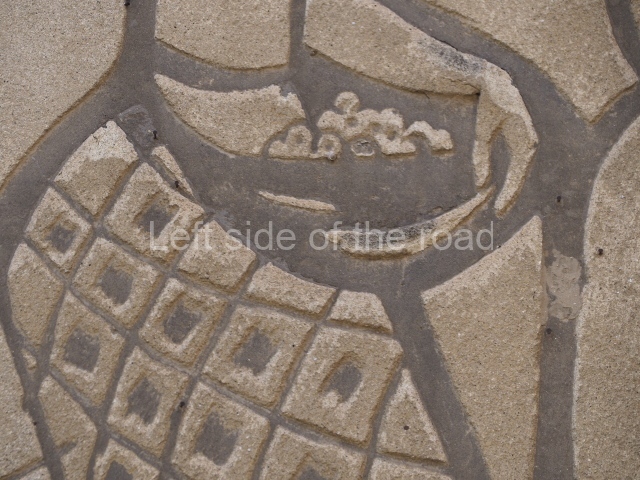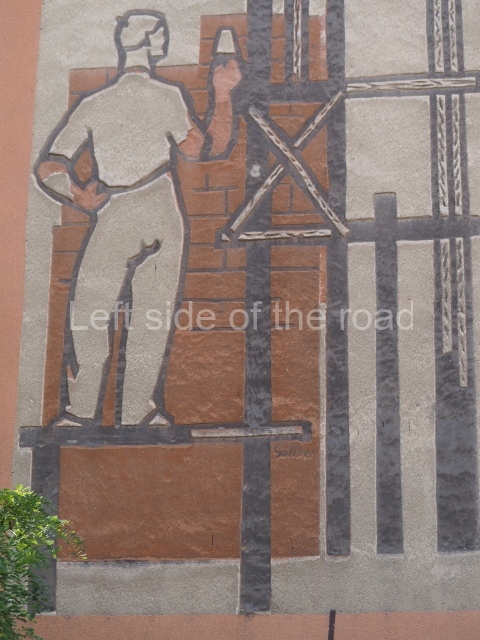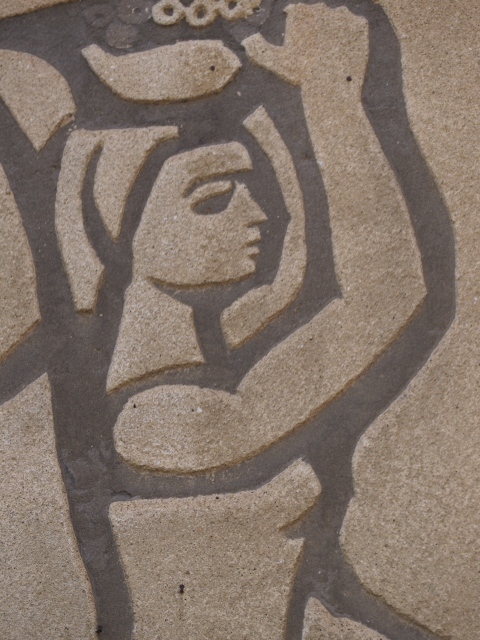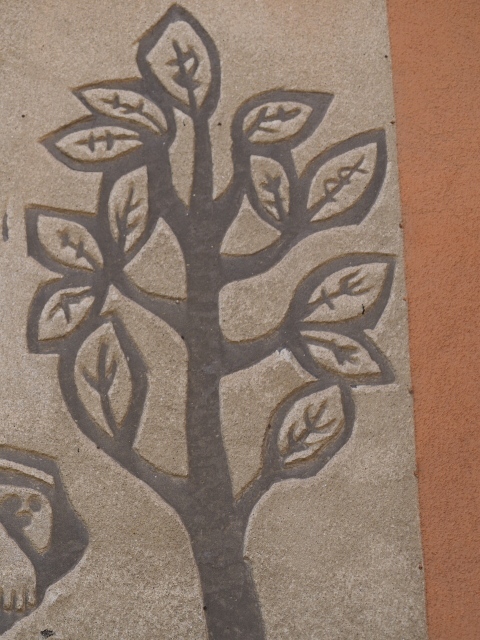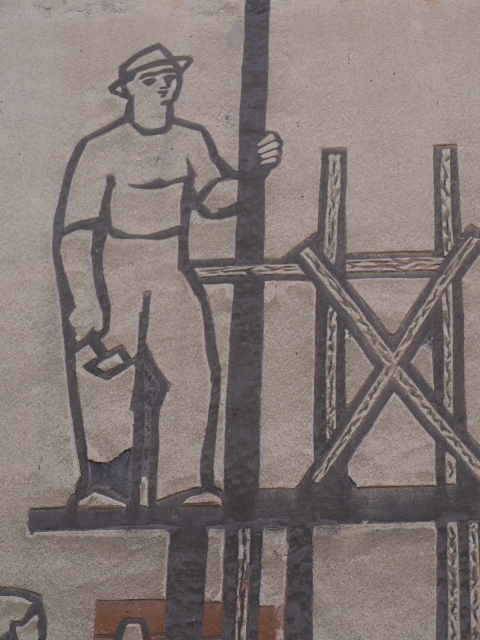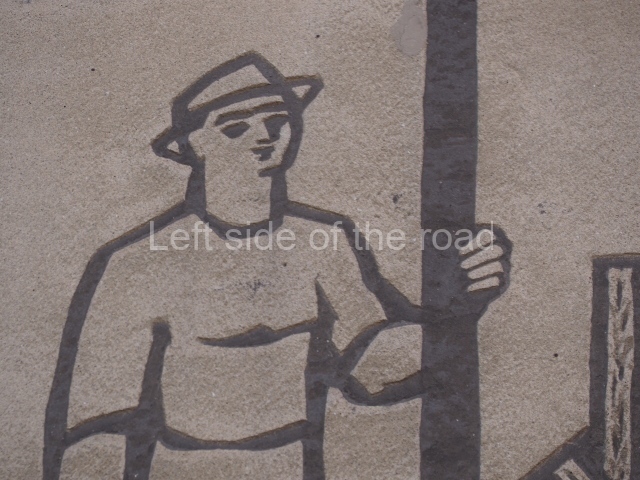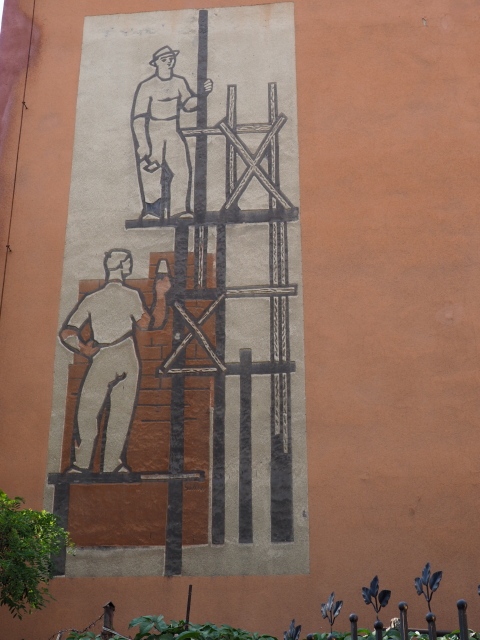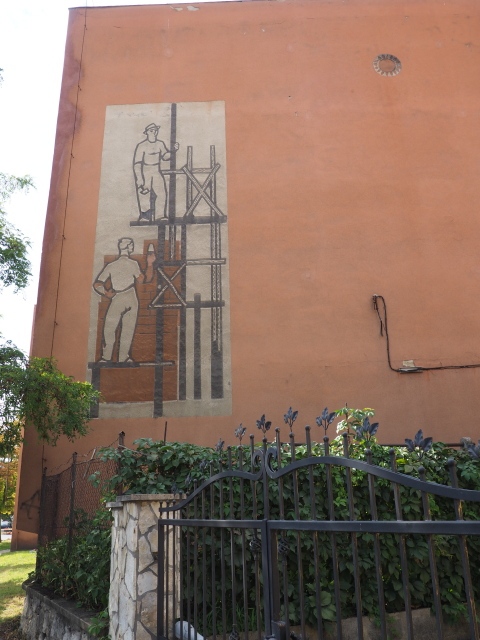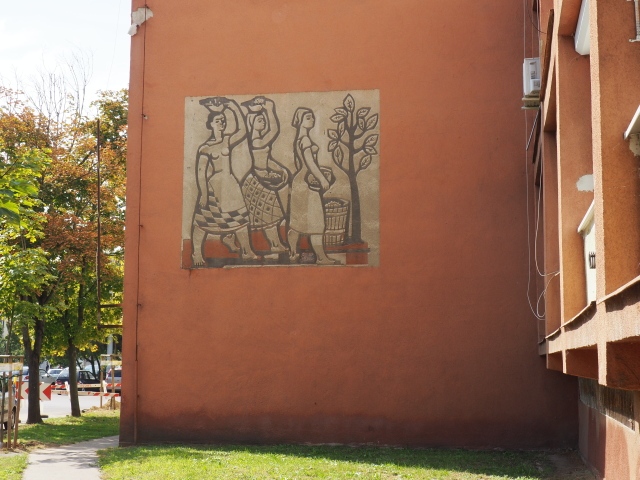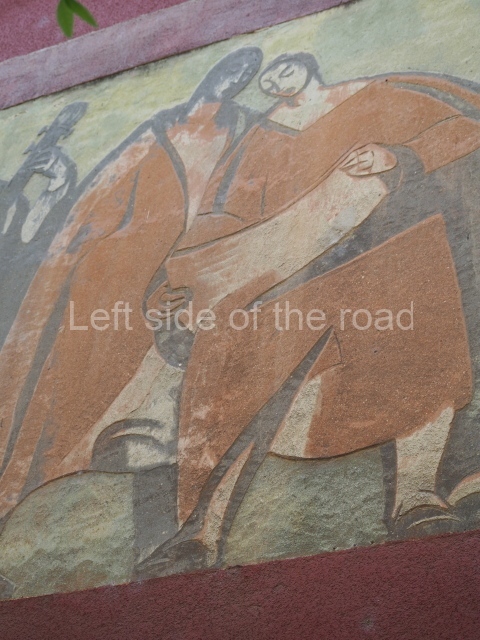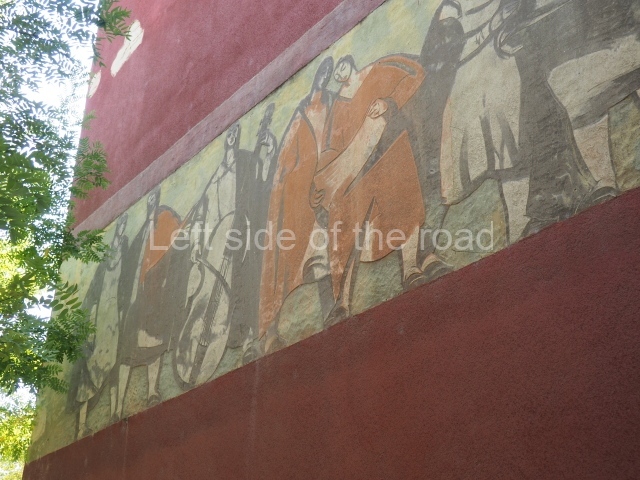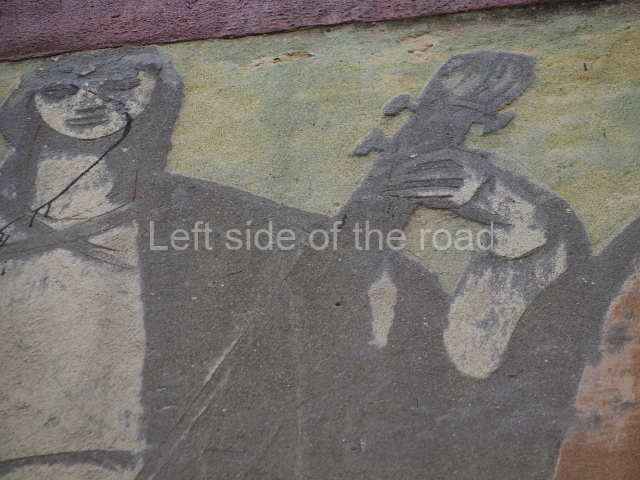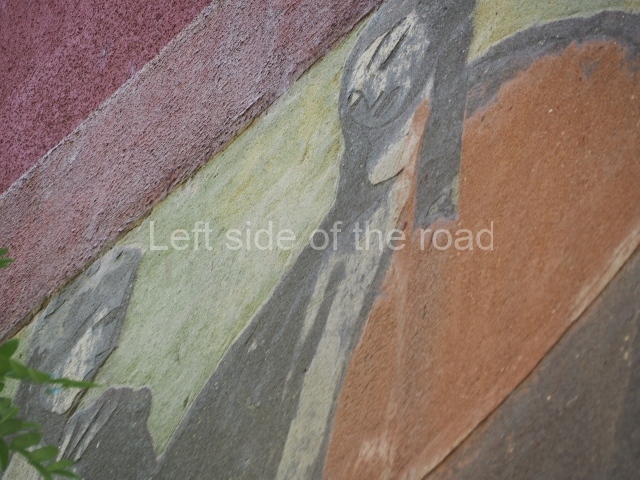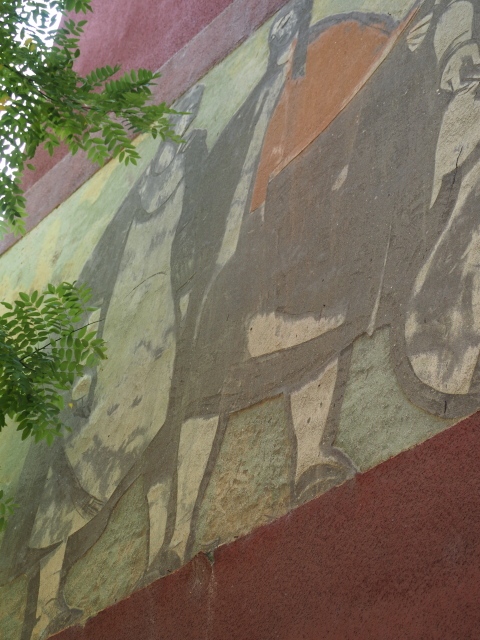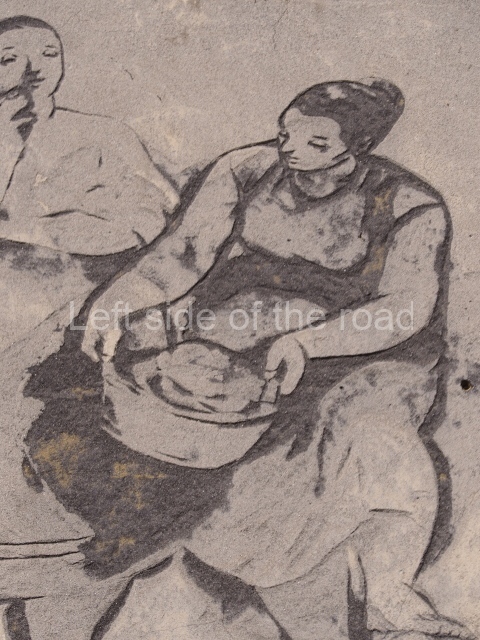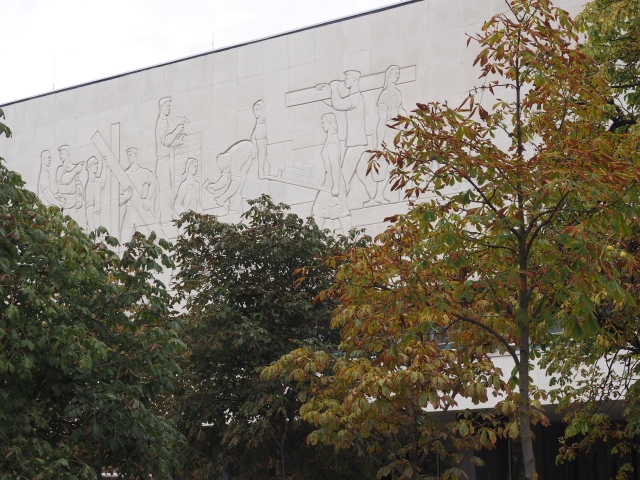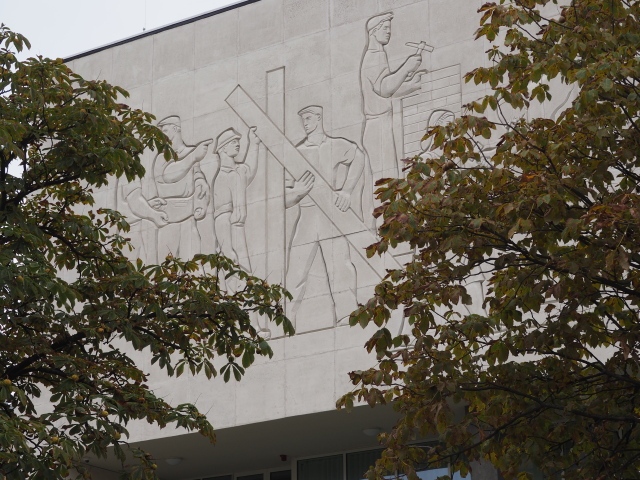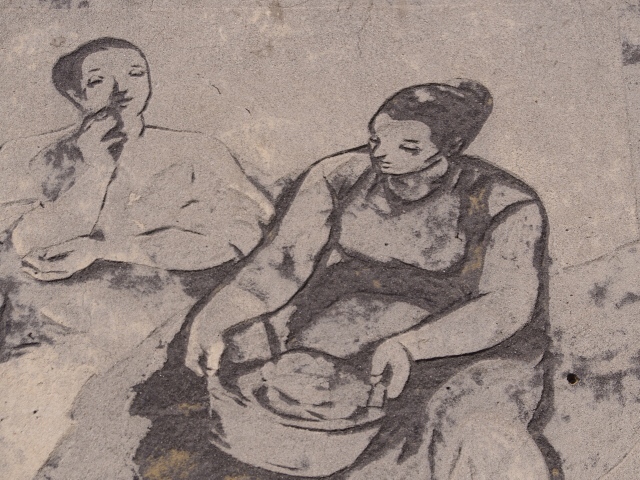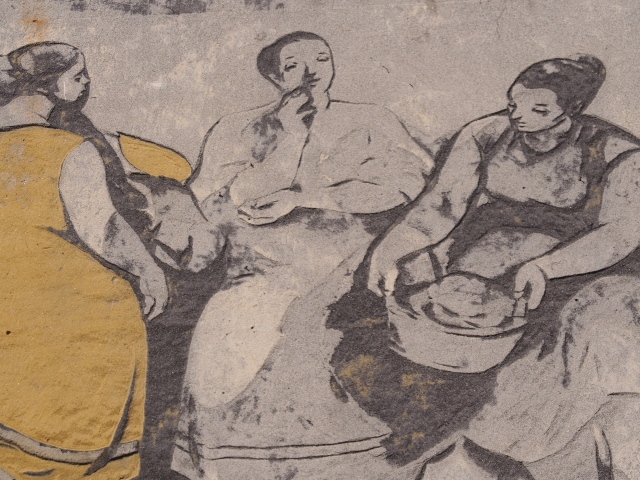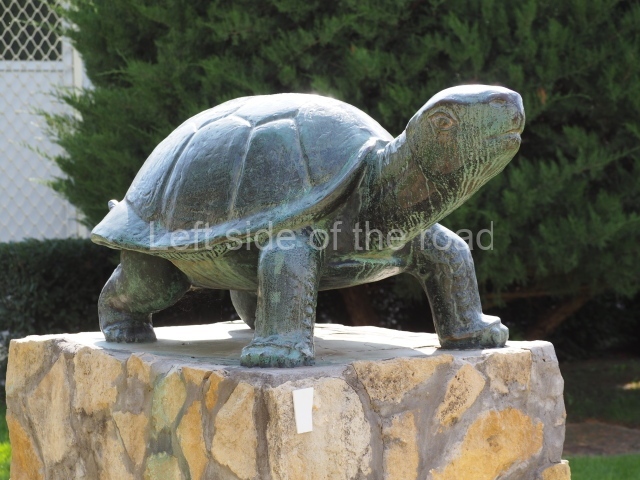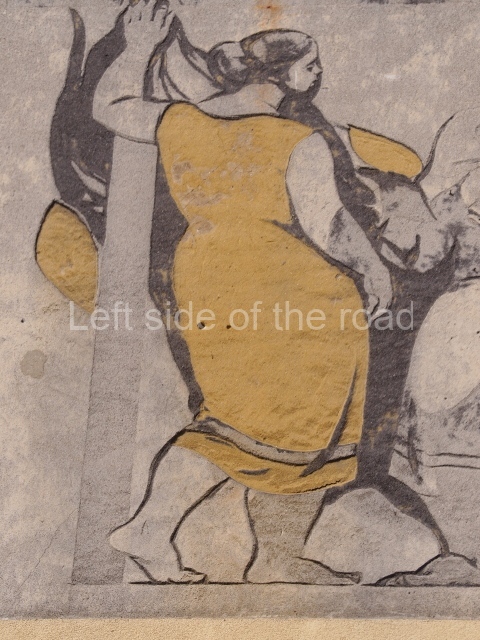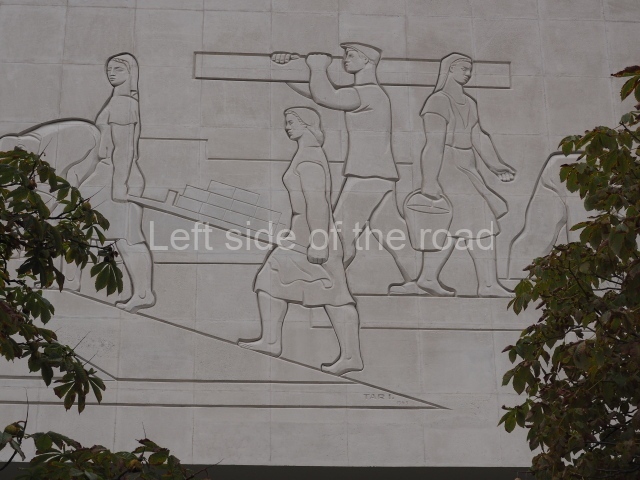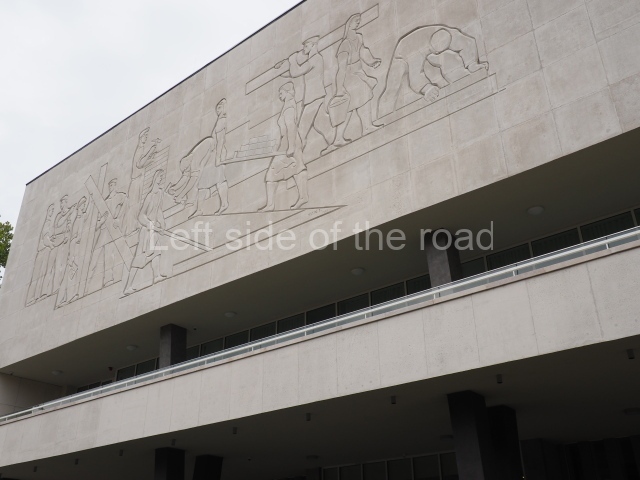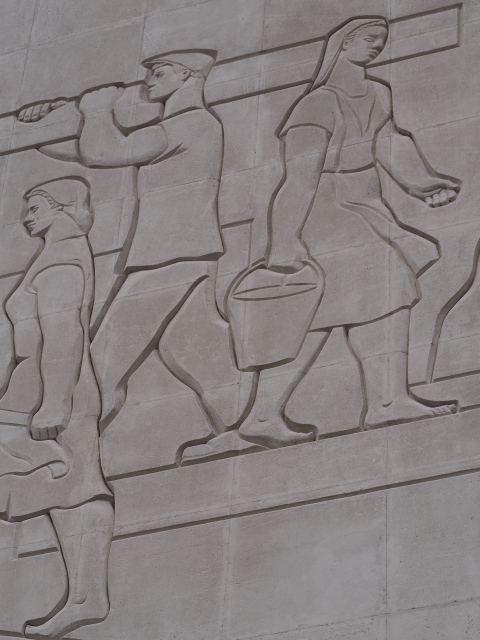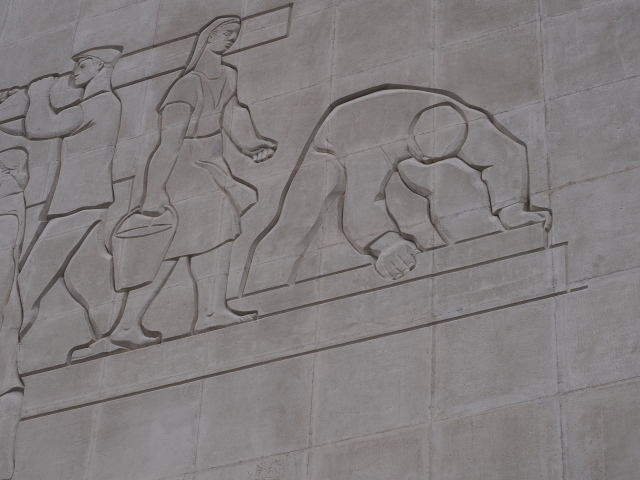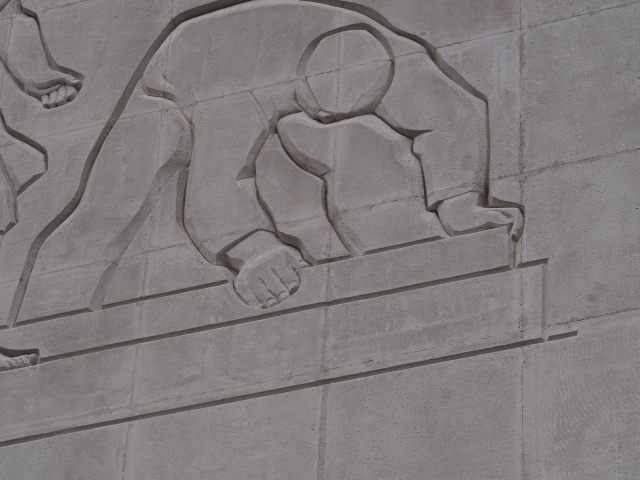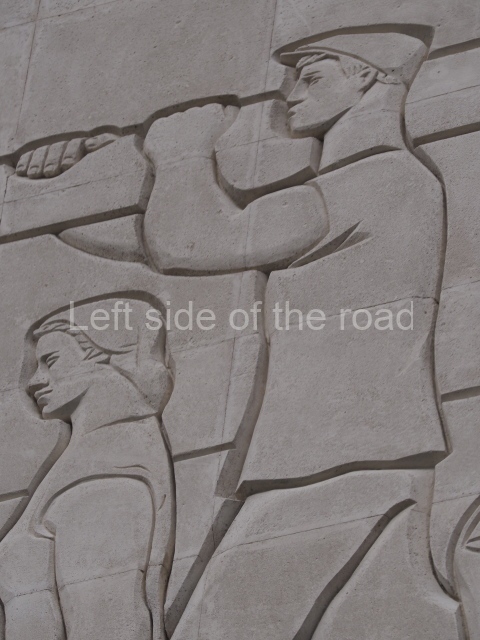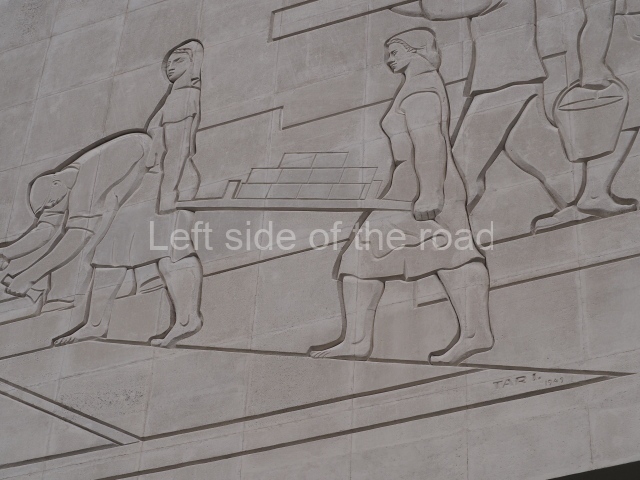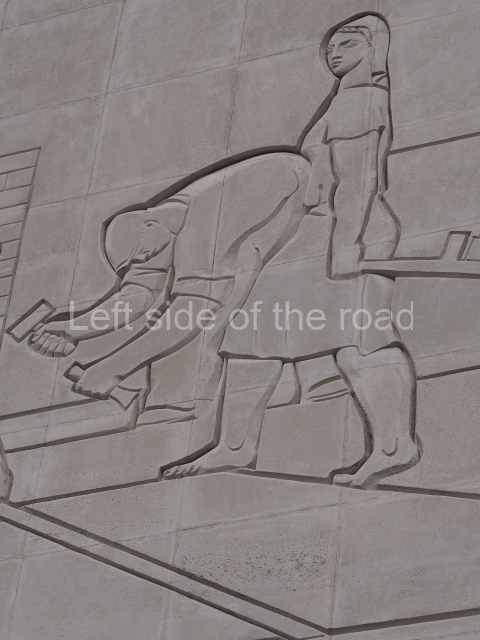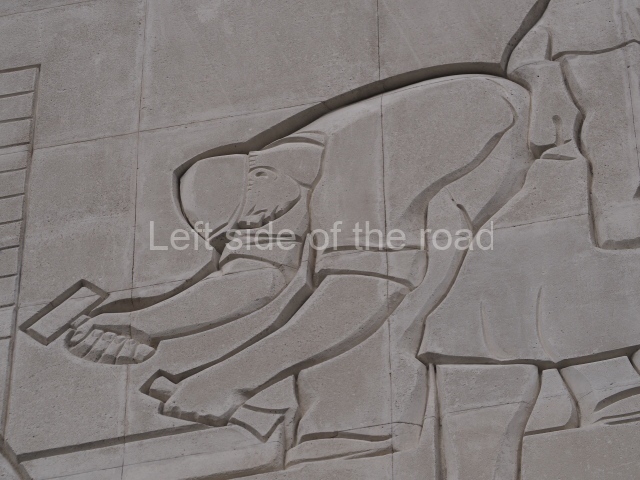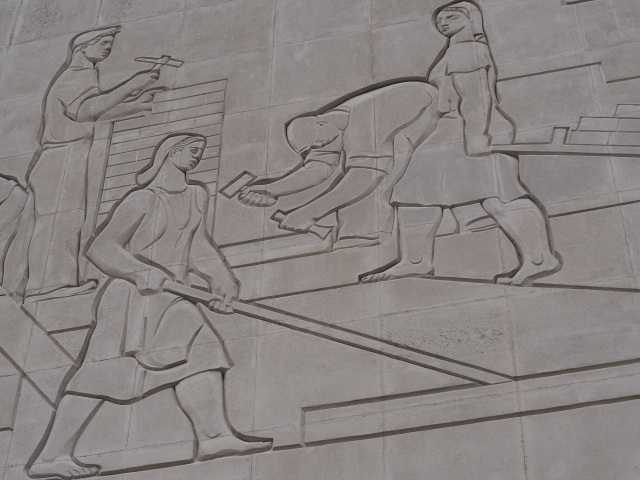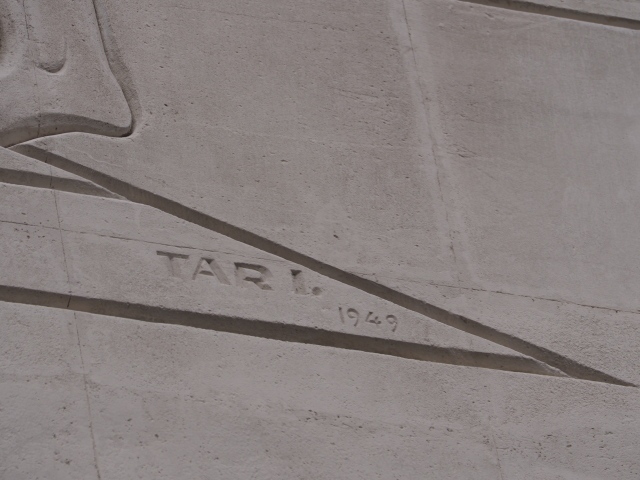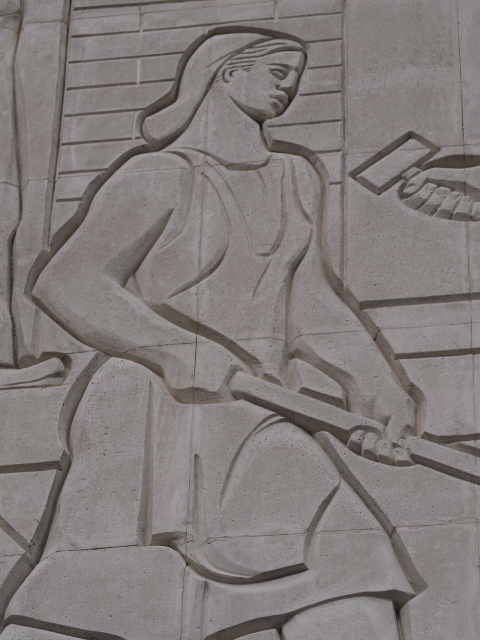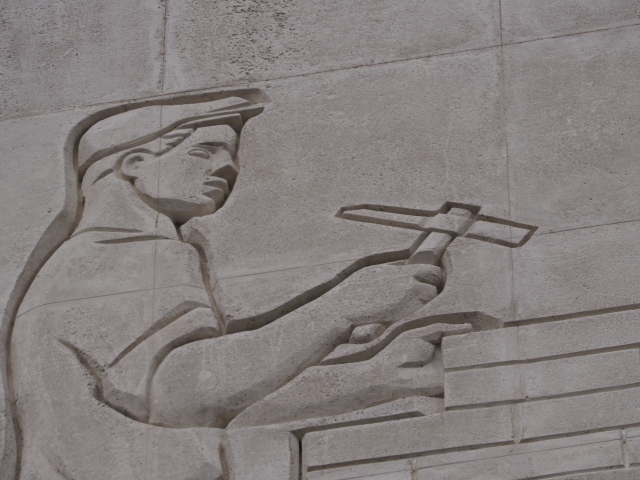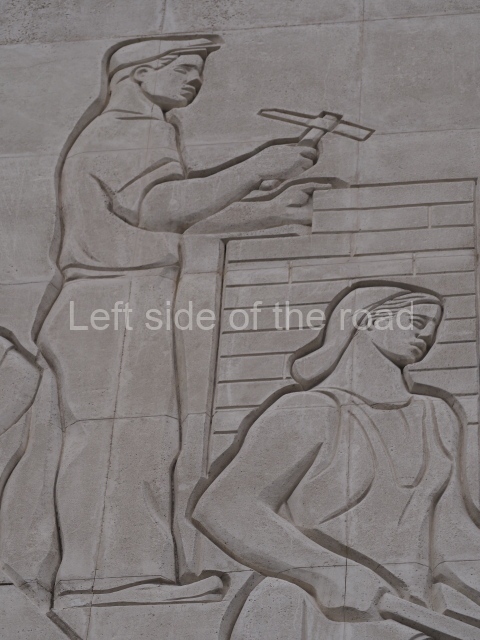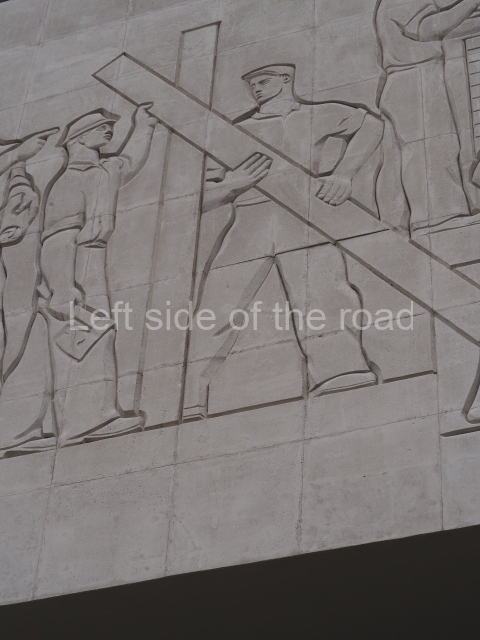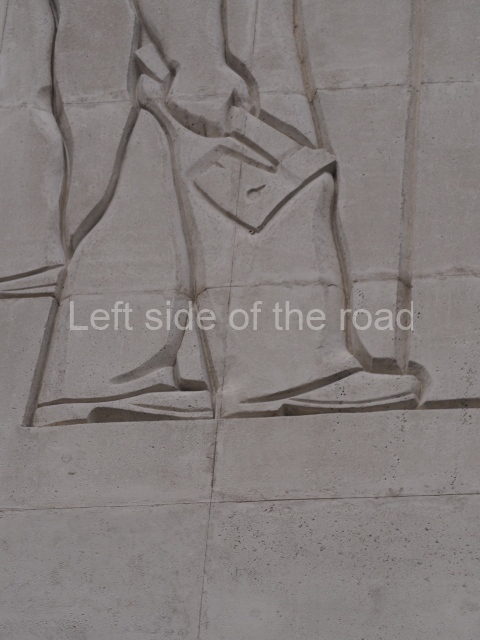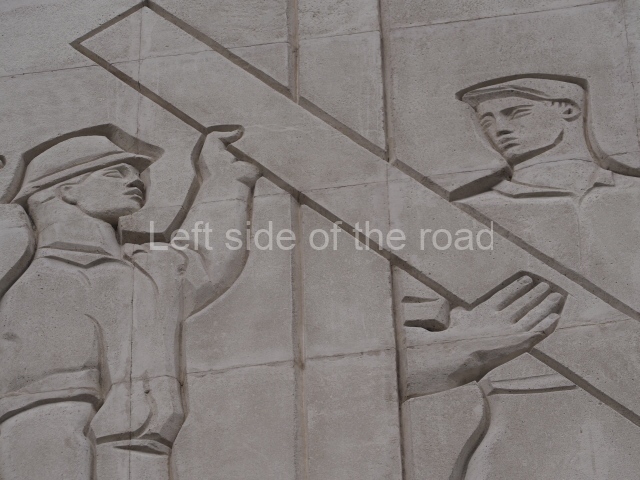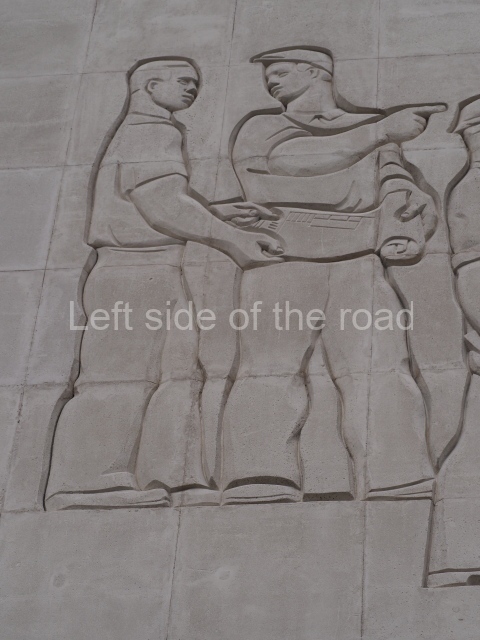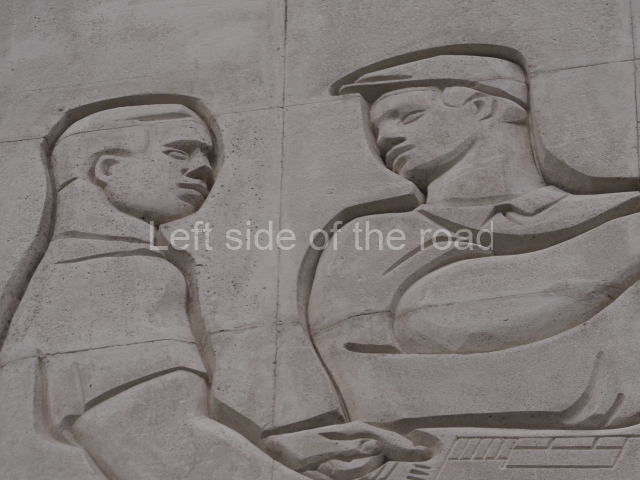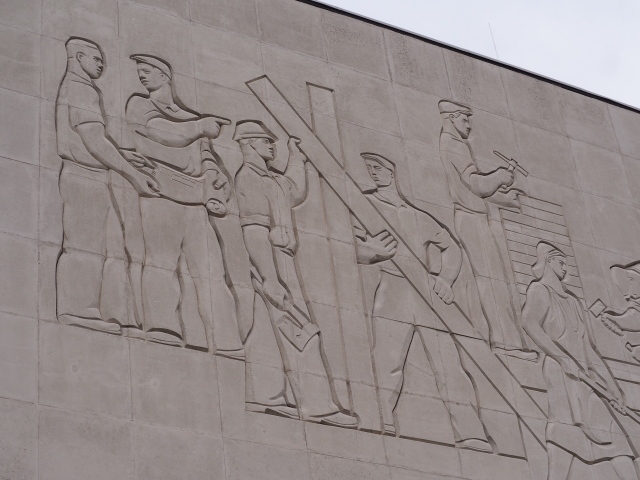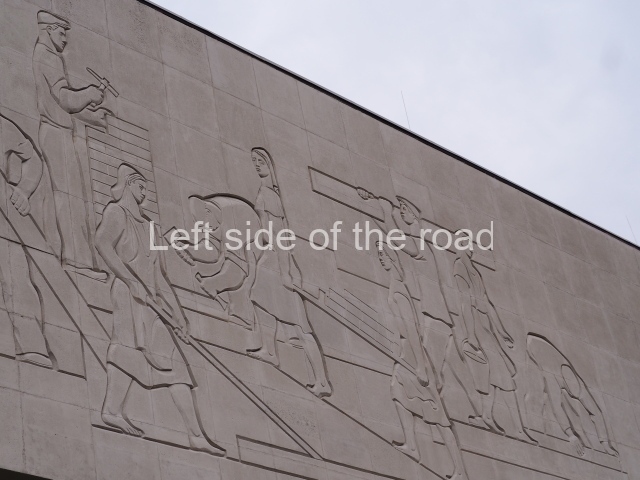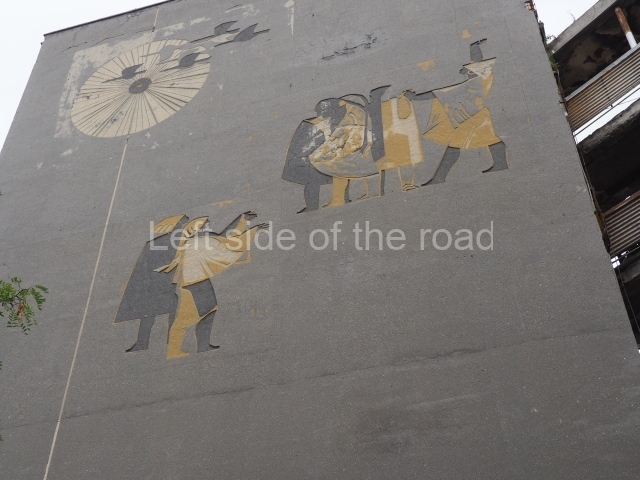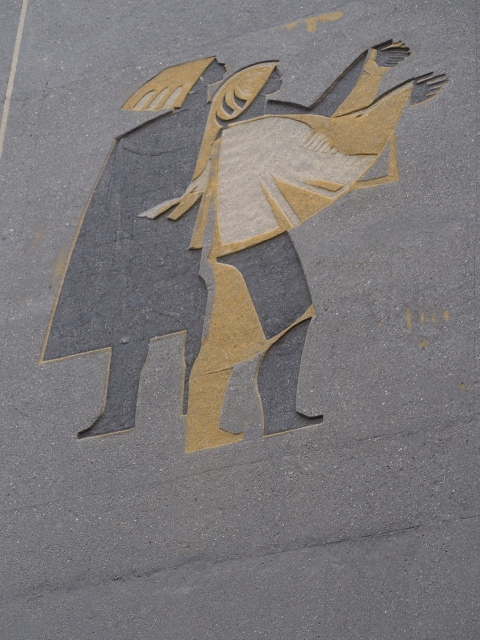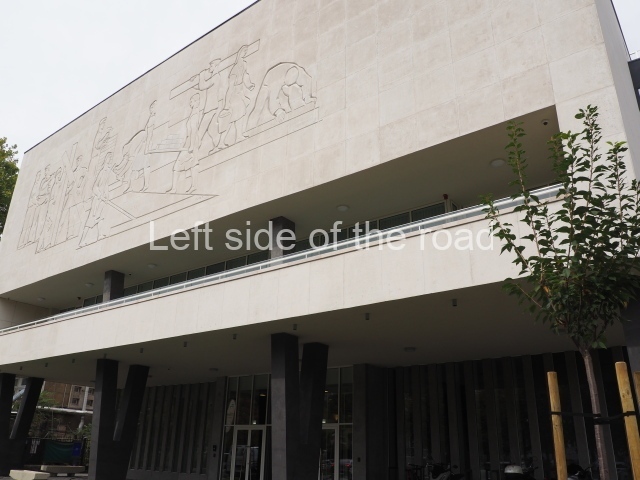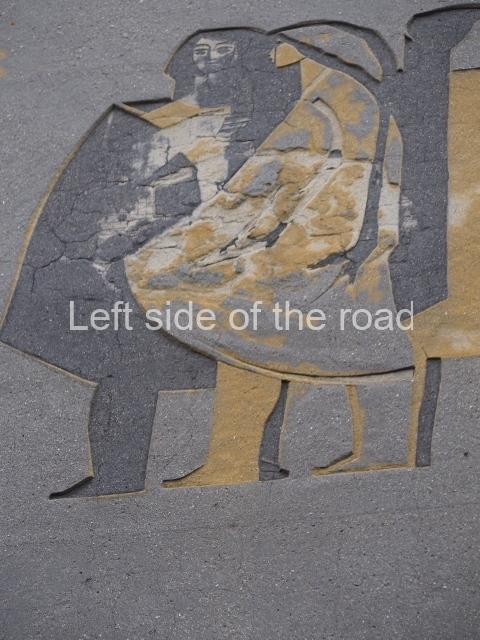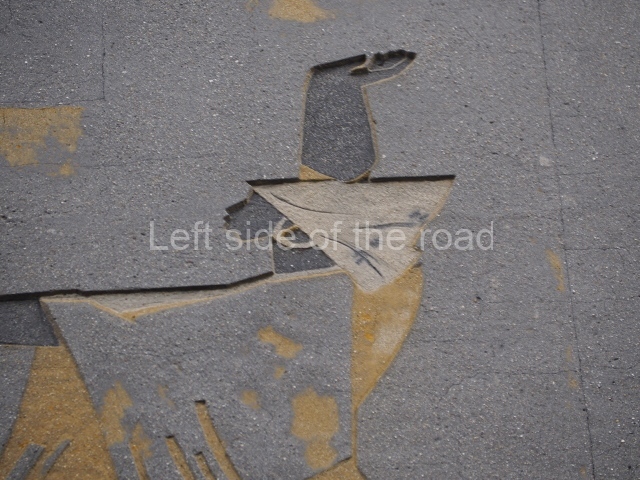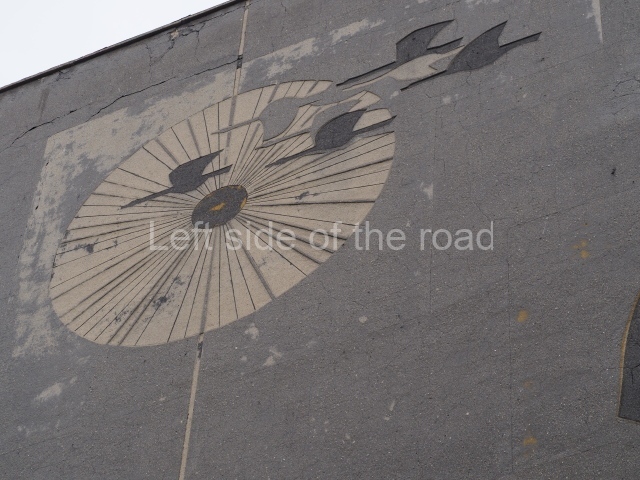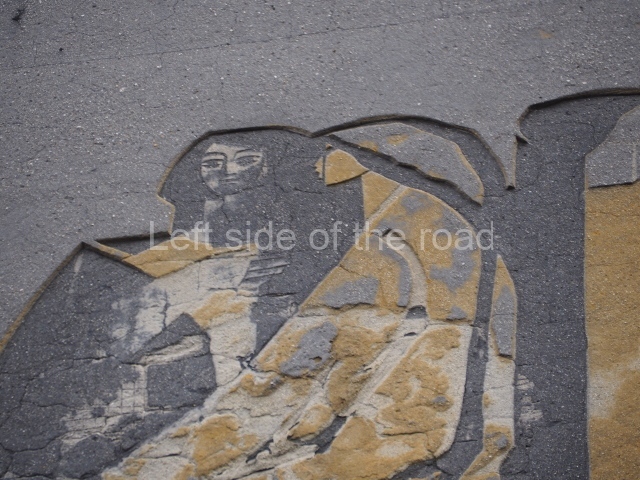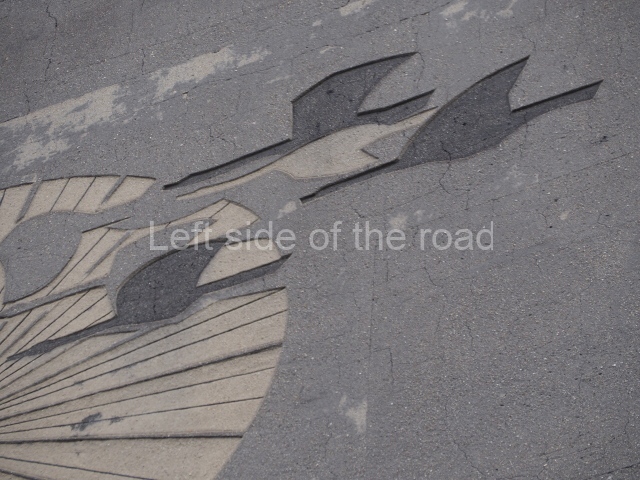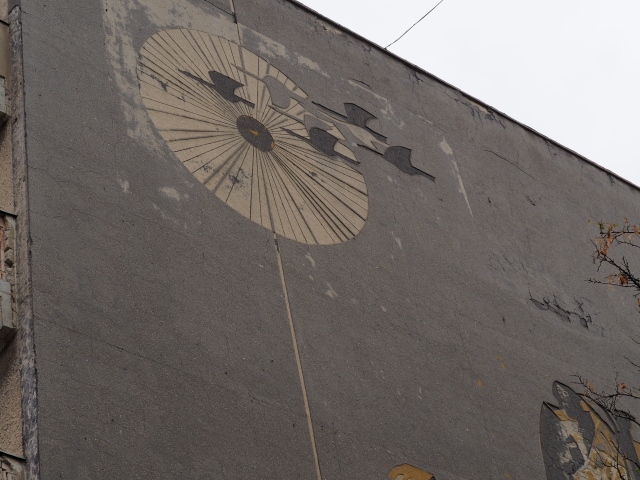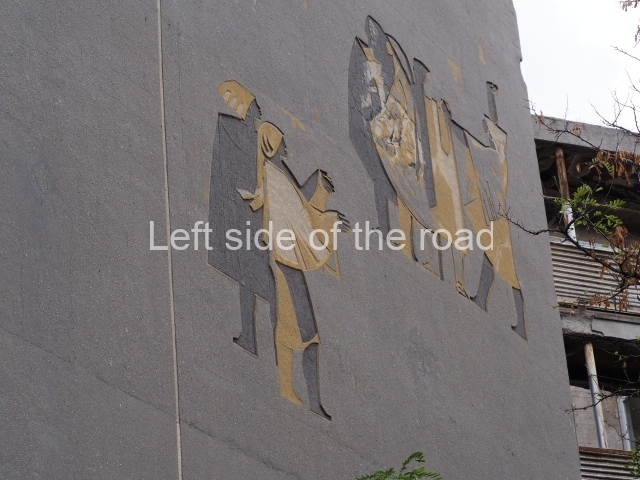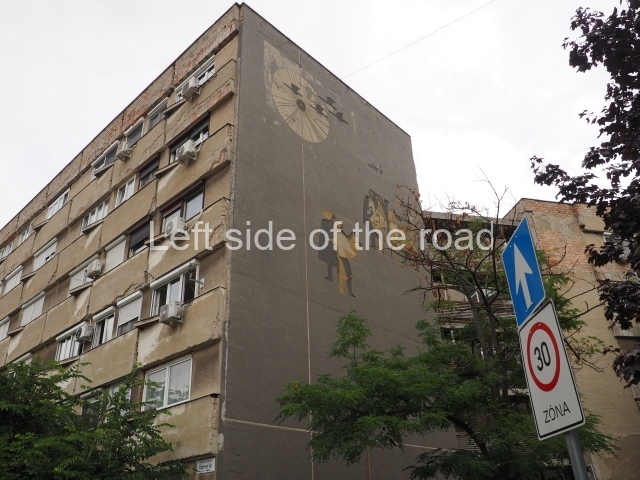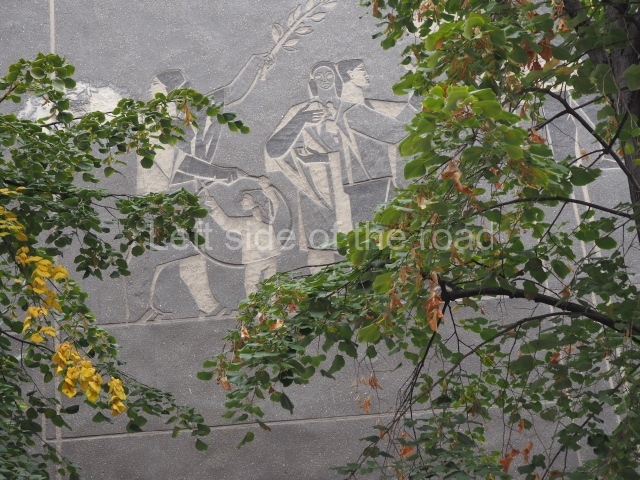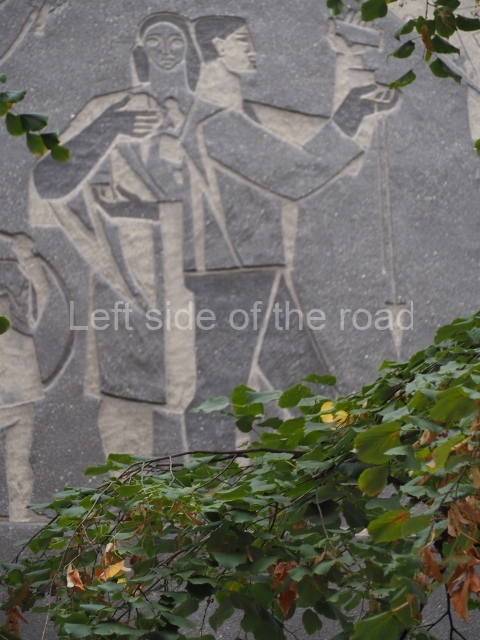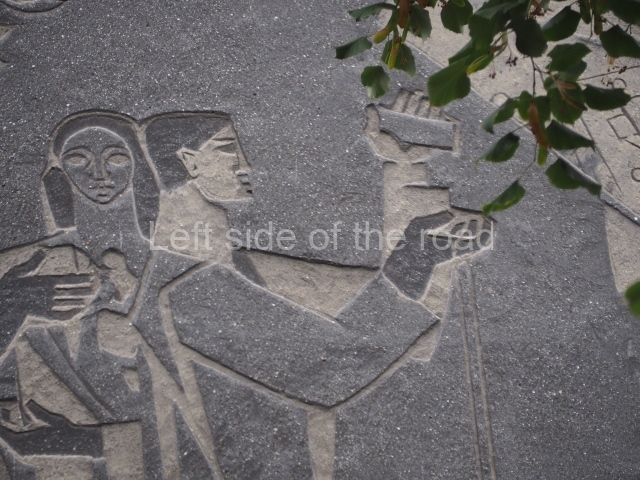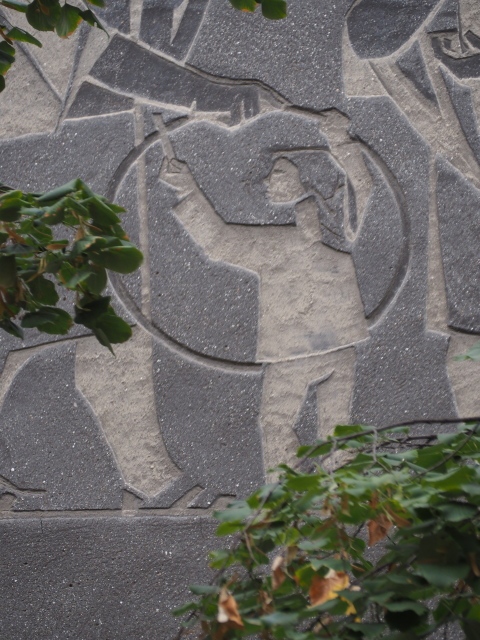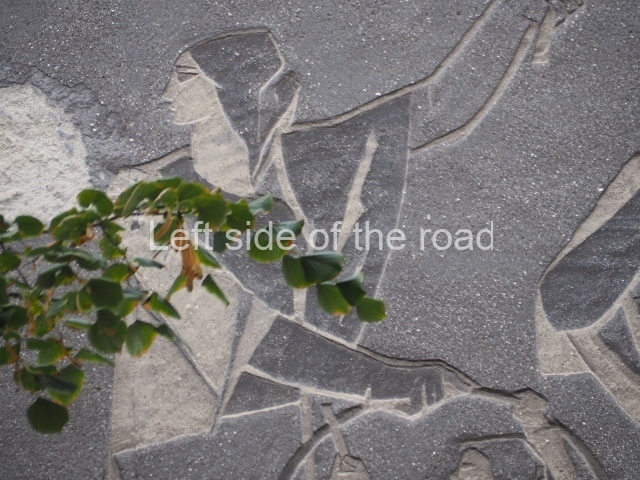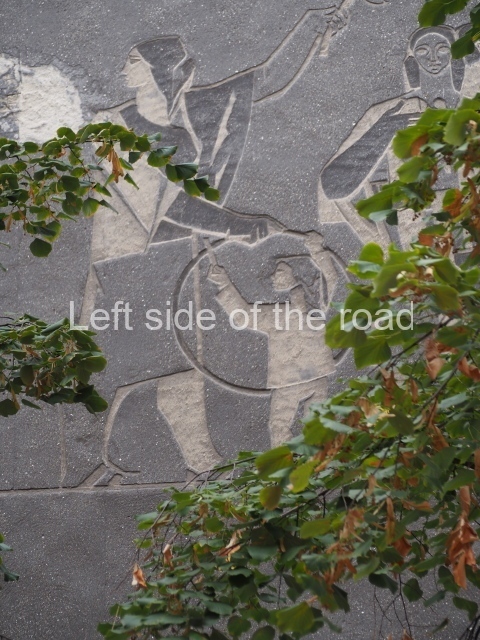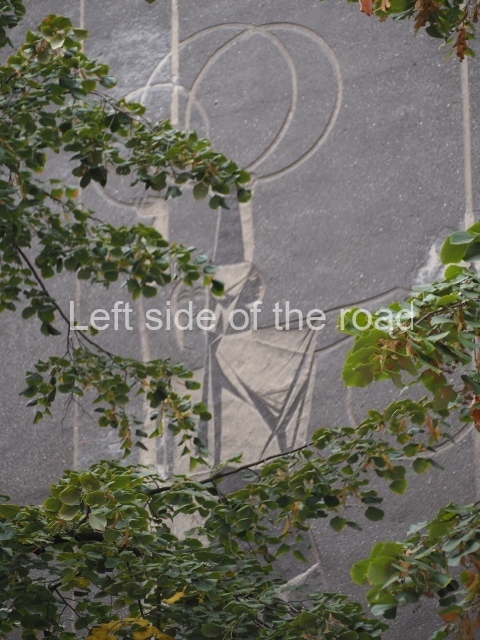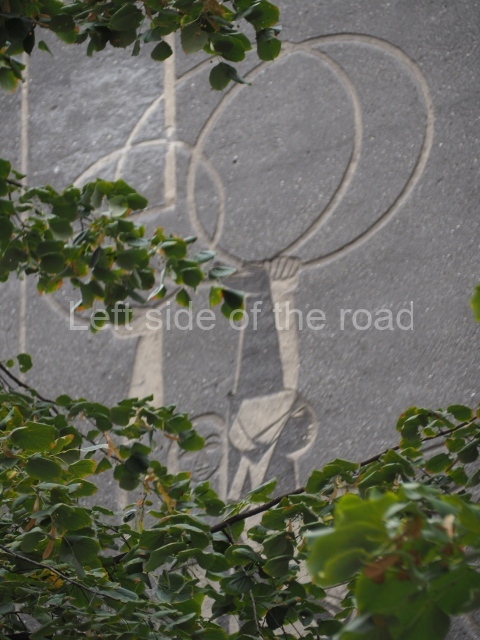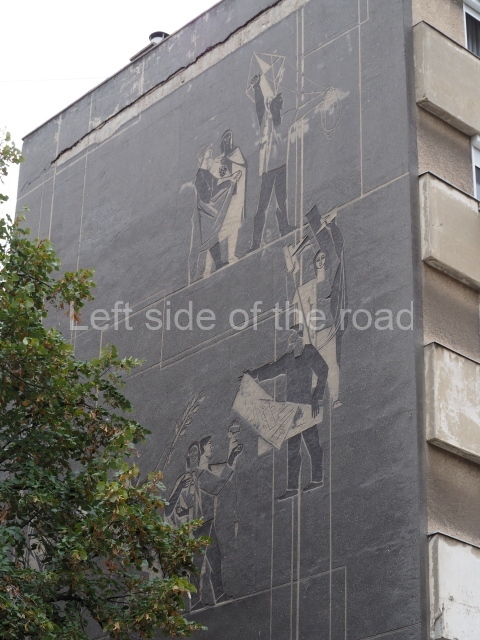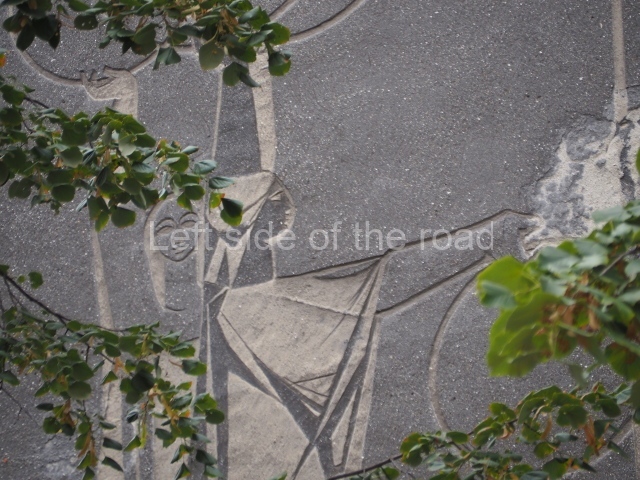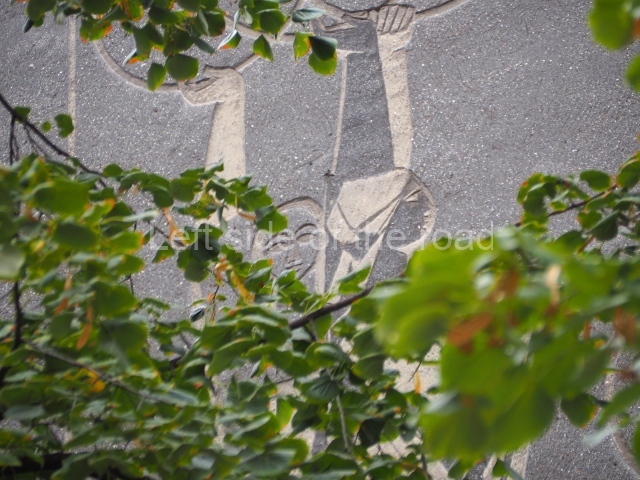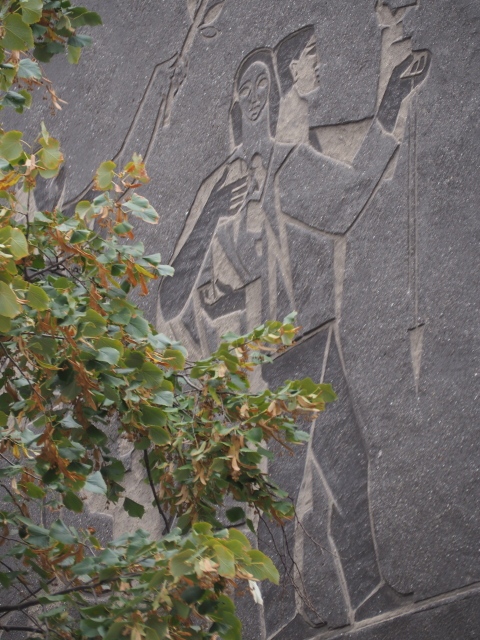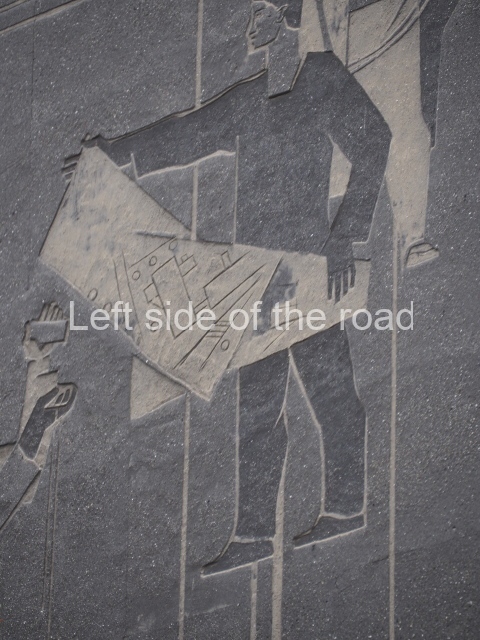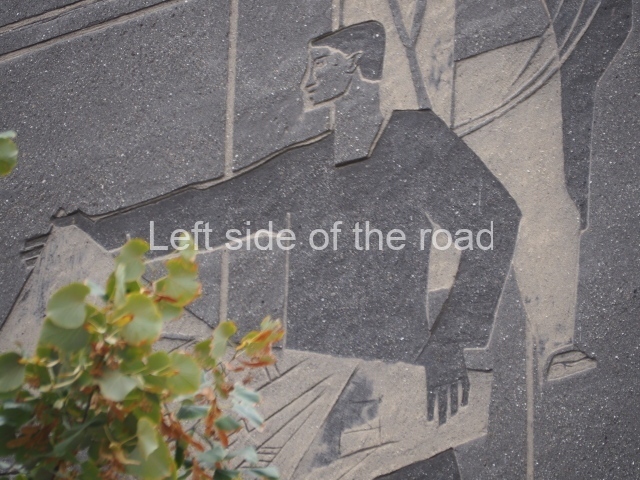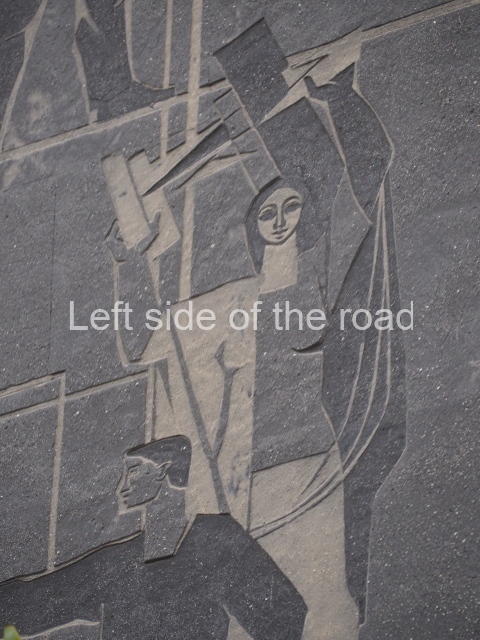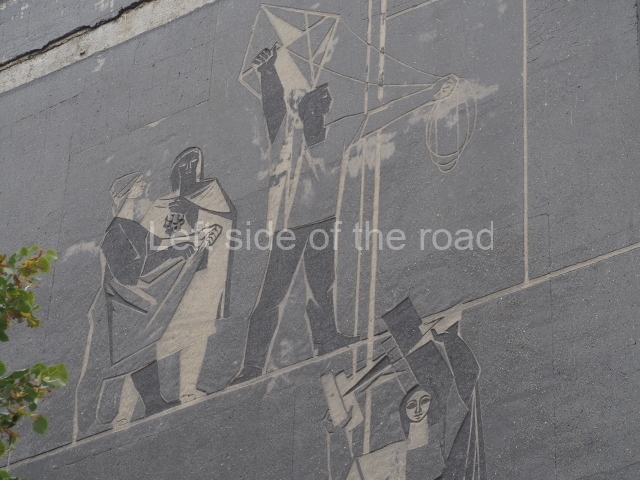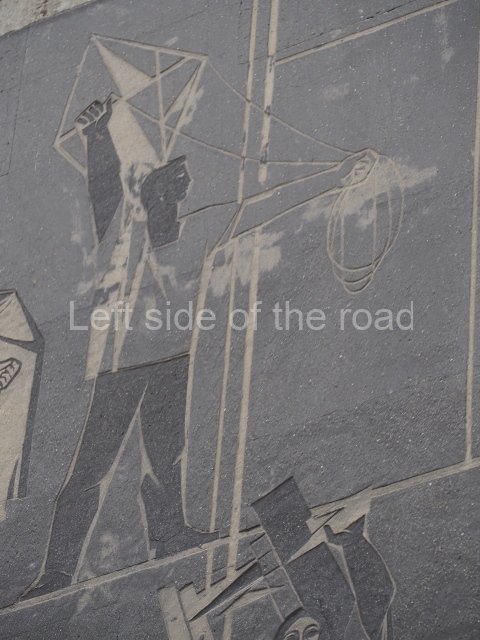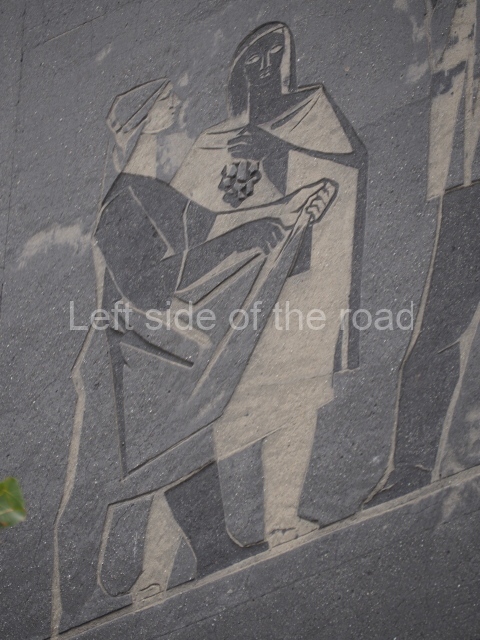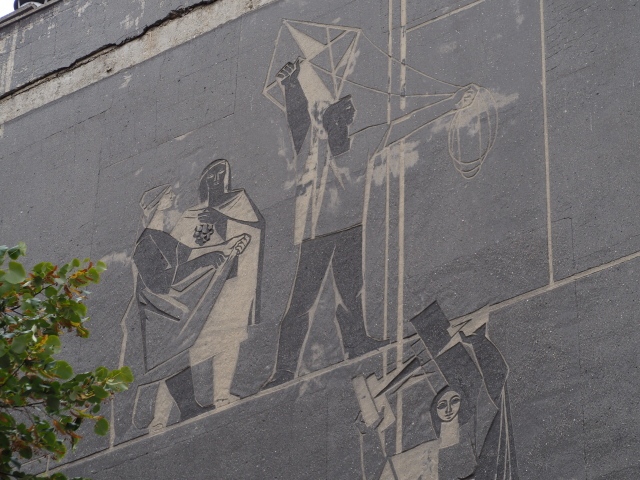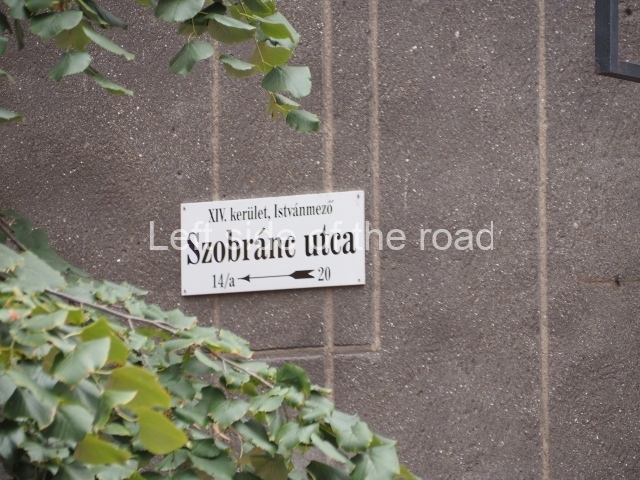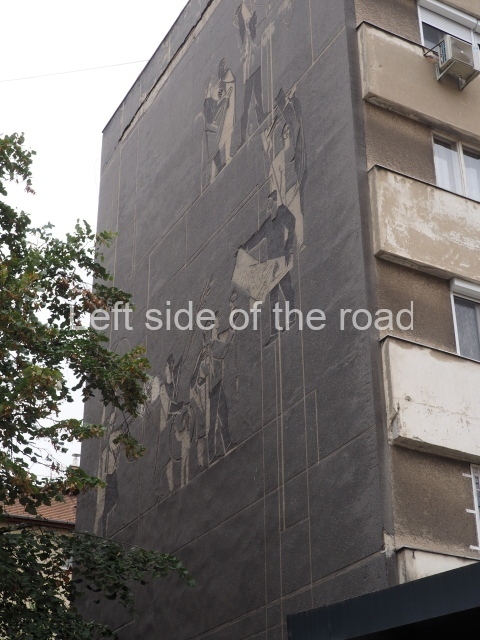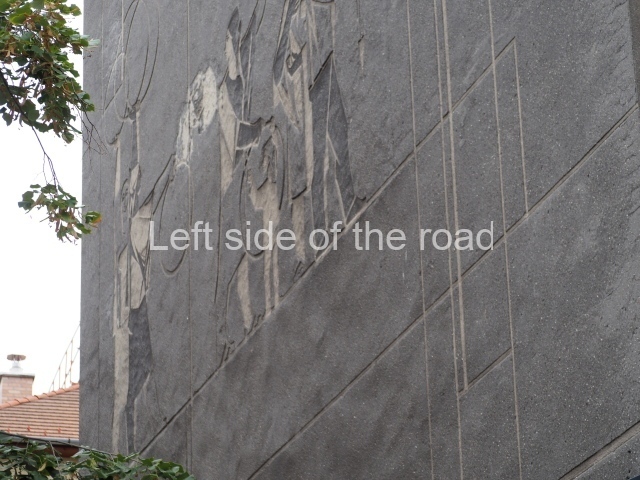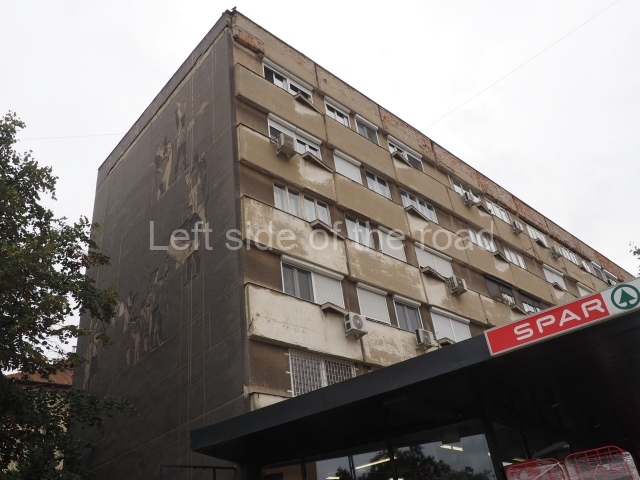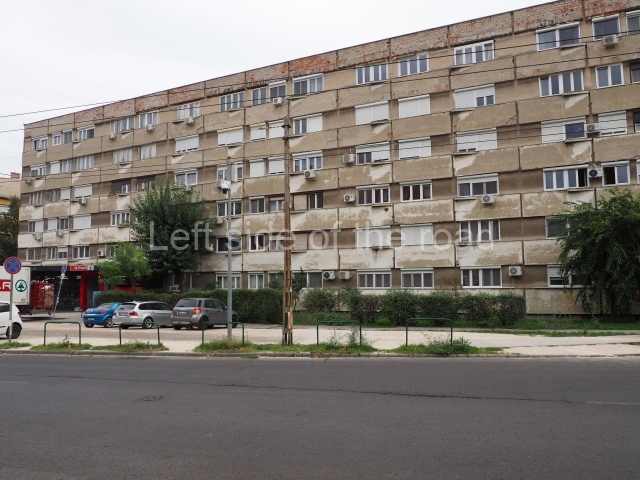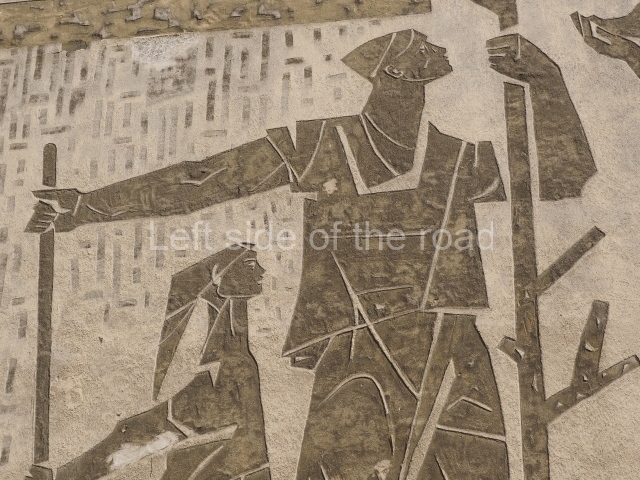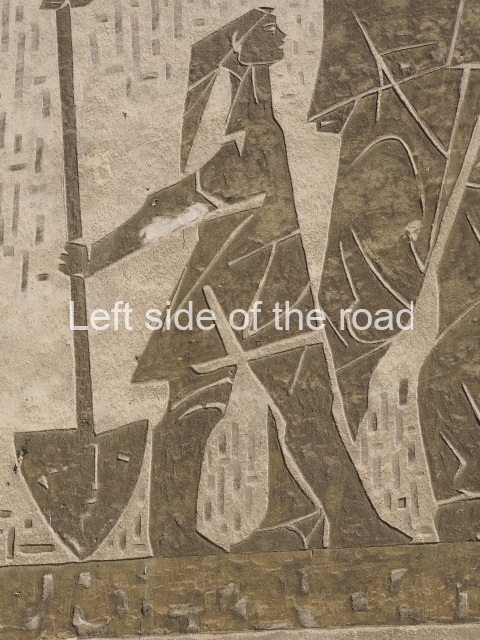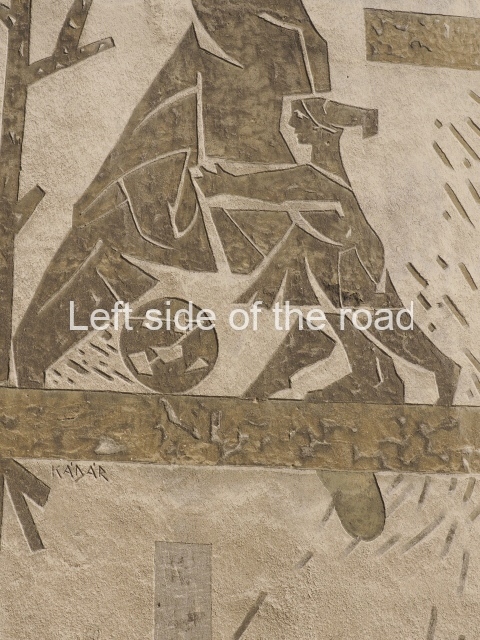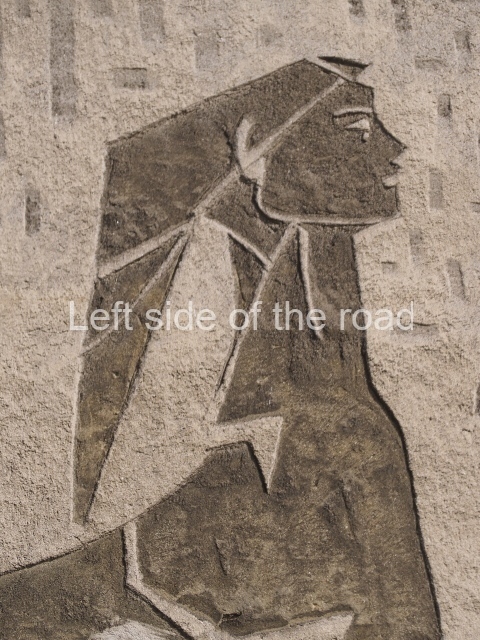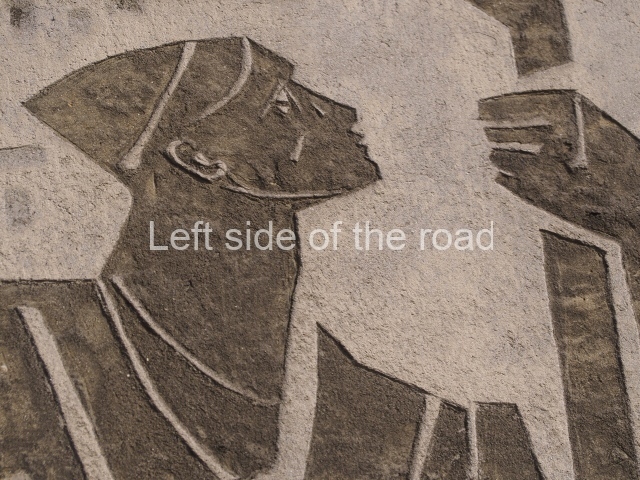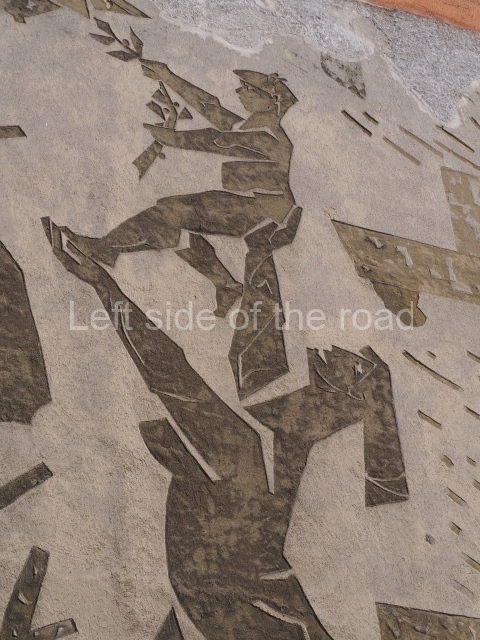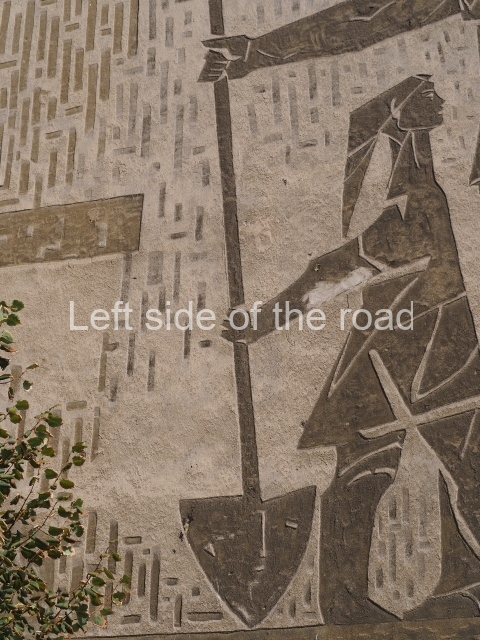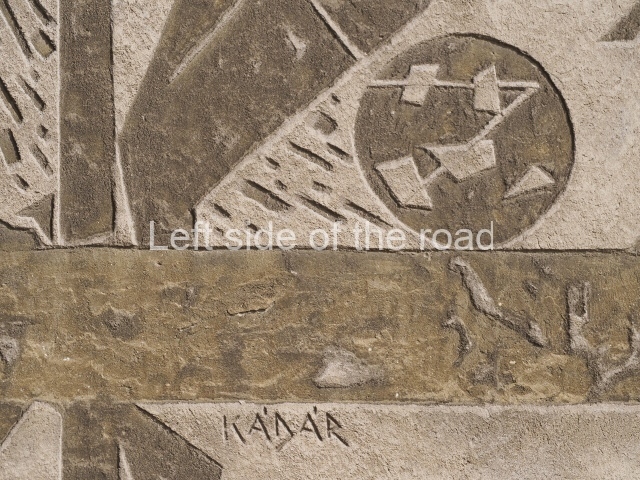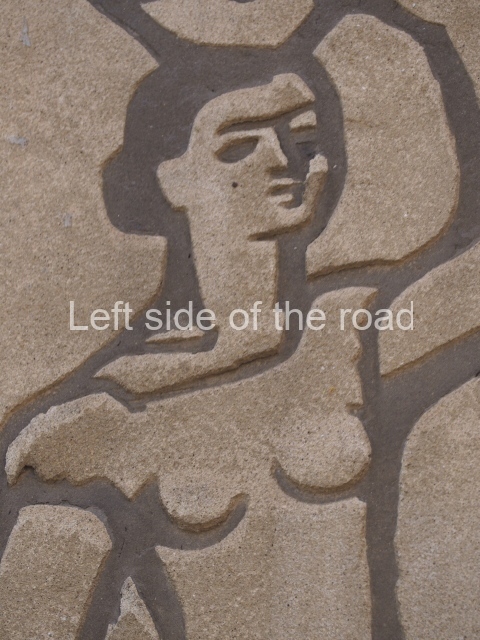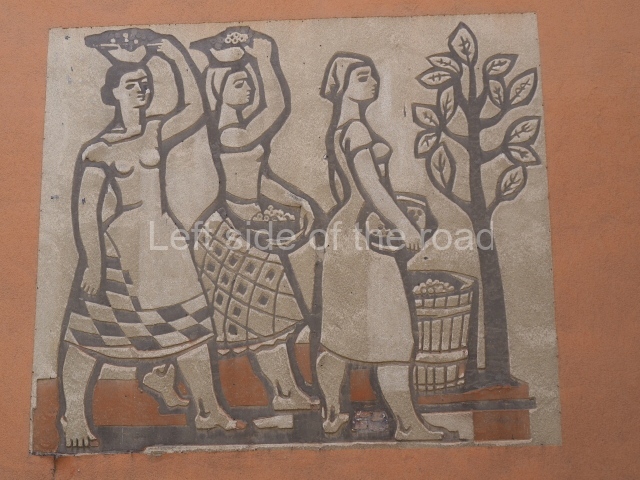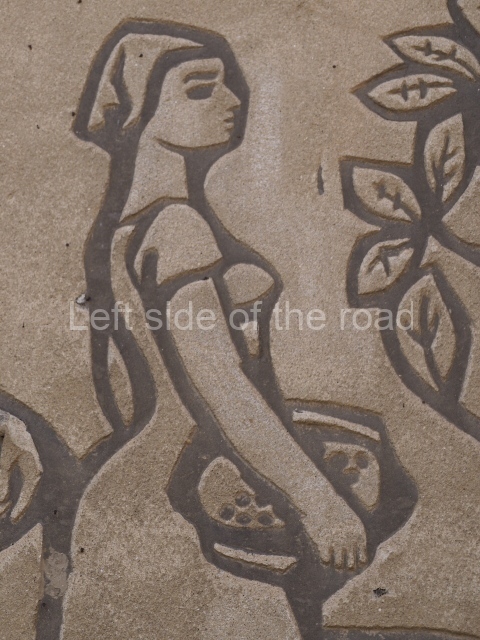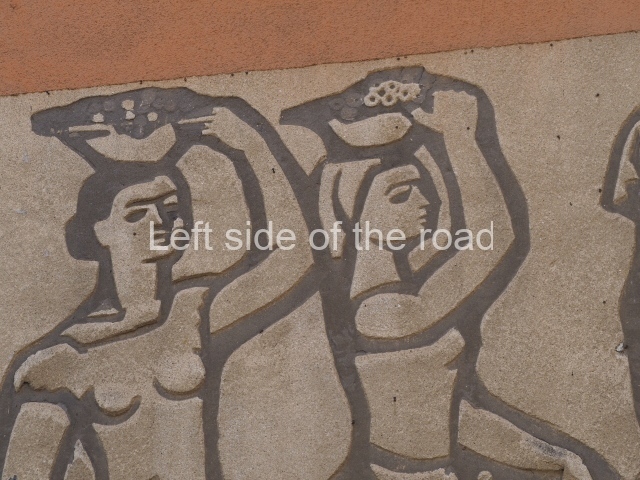Szent László tér, Városligeti fasor, Gizella út and Szobránc u. murals
Some of the remaining murals which decorate the side of blocks of flats and official buildings created during Hungary’s Socialist period.
The five murals in Szent László tér
The largest is on the side wall of a block of flats which is located in Klapka György u., one of the streets off Szent László tér. It fills most of the wall and tells the story of a family (mother, father, son and 2 daughters) working in the countryside. On the right the mother holds her son high above her head with both her hands as he is picking fruit from a tree. The youngest of the daughters appears to be playing with a ball just beside her mother (being too young to work). On the left the father and elder daughter have stopped working (planting another fruit tree and they both have their hands on a shovel) and are watching as the boy plucks the fruit. Surrounding the group are strokes of different lengths and thicknesses, possibly representing grass, trees and other plants in the countryside.
The image is very simple and stylised. If you saw the component parts of the image before seeing the whole you would have no idea what they represent. I have been unable to find out the exact process used to produce this art work but presumably more than one layer of concrete was applied to the wall, a darker layer being then covered with a thin screen of a lighter version added once dry. The design appears when the upper layer is removed, the depth of which will determine how dark the image will appear. I’m assuming this is the process used in all the murals in this estate as all the other four use more than one colour (as well as the two murals near the Puskás Arena).
The base on which the group stand is a thick, horizontal line that extends the full width of the wall and there are another four such lines, shorter in length, that are on either side of the group. It appears that something had, in the past, been engraved on these lines so it’s possible this image was part of some sort of campaign and included a political slogan.
People who might be familiar with other posts on this blog relating to art works created in the Socialist period of other countries will be aware that I don’t find this ‘propaganda’ aspect of Socialist Realist art a problem. After all, the advertising we are surrounded with in capitalist countries all have a message, mostly aimed at parting people from their money. Capitalism suggests it never uses ‘propaganda’ and that this is something only the populace of their enemies have to endure. However, this distinction is forgotten in times of conflict – take, for example, the posters produced in Britain in both the ‘World’ wars of the 20th century and even the ‘fear’ campaign about AIDS in the late 1970s.
The only information I have about this mural, and presumably the other four in this small estate, was that it was created in 1958 when the buildings were constructed. However, if you look underneath the ball and just to the left you will see the name ‘Kadar’. I have tried to find out more but the only Hungarian artist with that name I have come across died in 1956, before this mural was created.
Two of the other murals can be found on the opposite side of this block of flats.
The first one, on a wall that breaks up the façade looking into the square, is much smaller and much less ‘complicated’. It depicts three, young peasant women during harvest time. They are are carrying small baskets of a small fruit, either on their heads, in their arms or – the young woman in the centre – in her apron. I think this could be the harvesting of olives as the leaves seem be the right sort for an olive tree.
The third is on the very end of this same block of flats, next to a single story house. This is of two construction workers, a bricklayer – lower down and to the left – and what I think must be a scaffolder, who is in the process of erecting a wooden scaffold. This particular mural only takes up a small part of the wall, no more than a third, so what was the rationale with the installation of these murals is a bit of a mystery.
The fourth mural is on a different building completely. This is on the side of another block of flats which butts on to Türr István utca, another street that leads off the square, parallel to Klapka György u. When the trees are in leaf this is an easy mural to miss but probably easier to find in the winter. This one depicts a group of musicians and singers. You’ll be able to make out a lute (I think) and a large double bass as well as singers reading from sheet music.
The final mural in this grouping is on, yet again, another apartment block. This is high up on an end wall on Kiss Ernő u. – a street at 90º to the above mentioned streets and at the other side of the square. This is of a group of three older women who appear to be in the act of washing clothes.
Considering their age (and the likelihood that little attention has been paid to their upkeep since the early 1990s) all these five murals are a very good condition.
You know you are in the right square when you see the large statue of the turtle.
Location;
All five of these murals are in the vicinity of Szent László tér in Ujpest (that’s important as there’s another square of the same name closer to the centre of town which is very much a bus terminal).
GPS;
47.568688º N
19.095536º E
How to get there by public transport;
Get to Keleti railway station at the end of Metro line 4. From there you can either take the 30, 30A or 20E and get off a few minutes from the square. This is where a mobile phone comes into its own. Or you can go to Ujpest-központ, the last station north on Metro line 3 and from there take the short bus journey to Szent László tér on the number 220 bus.
The mural at 50 Városligeti fasor
This impressive mural is on the façade facing Városligeti fasor on a wall of what used to be the headquarters of the Nation Union of Hungarian Builders – MÉMOSZ. After the collapse of Socialism construction workers lost their organisation and hence had no need for such a large building and it was sold under a scheme of privatisation. The mural depicts a group of construction workers, both men and women, involved in the process of building a wall and laying a concrete floor. This is a busy scene with workers walking in both directions, other workers busy at their task and things happening on more than one level. There are labourers, bricklayers, carpenters and at the far left it looks like an architect talking to the foreman as one of them has a architects plan in his hands.
It uses the technique of cutting deep into the concrete façade and that gives the image a 3D effect. It’s also in a very good condition and looks like it must have had some maintenance work in the recent past.
Just behind the back foot of the second of the two women carrying a load of bricks up a slope you can see the name ‘Tari’ and the date 1949. This is the signature of the sculptor Istvan Tar (1910-1971).
Location;
50 Városligeti fasor
GPS;
47.51128º N
19.08006º E
How to get there by public transport;
Get to Keleti railway station at the end of Metro line 4. From there you can either take the 30, 30A and get off the stop for the Museum of Ethnology (the very modern building with an impressive and unique roof garden/observation platform). The mural is on the opposite side of the road to the museum, almost directly across from the lowest point of the roof garden.
The murals at Gizella út and Szobránc u.
There are two separate addresses for these murals but they are actually at either end of the same building – it just unites the two streets.
The first one is next to Gizella út 17 and, at least for me, is a little difficult to understand. At the top left of the wall there’s what looks like a representation of the sun and there’s a flock of long-necked, long-legged birds (cranes, storks?) flying in front of it.
Next, lower down and more over to the right is a group of four people (although it’s difficult to make that out with the naked eye as bits of concrete that have fallen away obscure the original intention of the artist). These characters appear to be dressed in Oriental clothing and are in some sort of procession with the person at the rear with her right hand in the air. I say her as all the characters in this mural give me the impression of being female. What’s strange about this group is that they are not facing in the same direction. If we take the direction of movement from right to left only two are facing that way. One is facing backwards and the fourth is facing the viewer.
Below them, now back to the left hand side of the wall, are a couple of women who are looking up at the group of four, and pointing to them with both hands. Why? I haven’t a clue.
If my theory (stated in the description of the first mural on this page) that the image is made up of various layers of coloured concrete to be able to provide colour to the image then that layering will produce weak points – and especially in an environment where the temperatures can often drop below zero in winter months and where there’s a lot of rain that can mean bits drop off over time. Of the murals described on this page this is the one that has suffered the most (almost certainly) environmental damage.
This mural is the work of Andrea Michnay and was completed in 1963.
The other mural attached to this building (which, I understand, was built as accommodation for workers of the Ministry of the Interior) is located at Szobránc u. 18.
It depicts groups of families or friends in a park, some of them flying kites, but it’s a little confusing.
In the bottom centre there’s a very young girl with what looks like a hula-hoop but I’m not too sure why her mother has an olive branch held high above her head. Over to the left, at the bottom, are a couple of young women playing with rings, so that may be what the very young girl is holding on to, not a hula-hoop.
The couple at the bottom right are both holding the strings of a kite, the woman with a spindle and the man with what looks like a hand grips in his left hand but his right hand is seeming to stretch out to the man above, who is holding a large sheet of paper, with some geometric designs on it. Is this a plan for a park, is he an architect, as he doesn’t seem to be there for play?
Above him, still on the right of the image, is a woman holding a large box kite with all kinds of strings hanging from it. Could she be the one who’s holding the kite the couple at the bottom are in the process of trying to launch?
At the very top is a man standing holding both a kite and its strings. Behind him are two women but its difficult to work out what they are doing.
One of the problems of trying to interpret these murals is that here, as with the mural of the musicians in Ujpest, the trees get in the way and these sort of murals are meant to be seen face on. If you have to look at them from the side you get a distorted view of events.
This mural is the work of István Petrilla and was also completed in 1963.
Location;
They are on either end of a block of flats on Egressy út, between Gizella út and Szobránc u., there’s a Spar supermarket on the ground floor.
GPS;
47.508314º N
19.100207º E
How to get there by public transport;
From Keleti railway station take the 5, 7 or 110 (or any other bus that goes along Thököly út) and get off at Gizella út.










